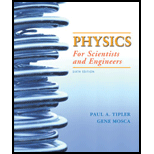
Concept explainers
(a)
To Calculate:The size of the semi major axis of the planet’s orbit.
(a)
Answer to Problem 20P
Explanation of Solution
Given data:
Here,
Orbital period:
FormulaUsed:
According to Kepler’s third law of planetary motion, the square of the orbital period of a planet is directly proportional to the cube of the semi-major axis of its orbit.
Here,
Calculation:
Rearrange this equation for
Convert the orbital period of the planet from years to seconds.
Calculate the size of the semi major axis of the planet’s orbit
Substitute
Conclusion:
The size of the semi major axis of the planter’s orbit is
(b)
To Calculate:The mass of the planet as compared to the mass of jupiter.
(b)
Answer to Problem 20P
The mass of the planet is
Explanation of Solution
Given data:
Mass of the planet =
Mass of star=
Formula Used:
Use conservation of momentum principle for the planet of mass
Here,
Calculation:
Since,
Calculate the orbital speed of the planet.
Substitute
Calculate the mass of the planet
Substitute
Compare the mass of the planet with the mass of the Jupiter
Conclusion:
The mass of the planet is
Want to see more full solutions like this?
Chapter 11 Solutions
Physics For Scientists And Engineers
- A tunnel is dug through the center of a perfectly spherical and airless planet fo radius R. Using the expression for g derived in Gravitation Near Earth’s Surface for a uniform density, show that a particle of mass m dropped in the tunnel will execute simple harmonic motion. Deduce the period of oscillation of m and show that it has the same period as an orbit the surface.arrow_forwardShow that the areal velocity for a circular orbit of radius r about a mass M is At=12GMr . Does your expression give the correct value for Earth’s areal vilocity about the Sun?arrow_forwardFind the Hohmann transfer velocities, vEllipseEarth and vEllipseMars ,needed for a trip to Mars. Use Equation 13.7 to find the circular orbital velocities for Earth and Mars. Using Equation 13.4 and the total energy of the ellips (with semi-major asix a), given by E=GmMs2a , find the velocities at Earth (perihelion) and at Mars (aphelion) required to be on the transfer ellipse. The difference, v , at each point is the velocity boost or transfer velocity needed.arrow_forward
- Check Your Understanding Galaxies are not single objects. How does the gravitiational force of one galaxy exerted on the “closer” stars of the other galaxy compare to those farther away? What effect would this have on the shape of the galaxies themselves?arrow_forwardCompute directly the gravitational force on a unit mass at a point exterior to a homogeneous sphere of matter.arrow_forwardWhat is the orbital radius of an Earth satellite having a period of 1.00 h? (b) What is unreasonable about this result?arrow_forward
- A tunnel is dug through the center of a perfectly spherical and airless planet of radius R. Using the expression for g derived in Gravitation Near Earth’s Surface for a uniform density, show that a particle of mass m dropped in the tunnel will execute simple harmonic motion. Deduce the period of oscillation of m and show that it has the same period as an orbit at the surface.arrow_forwardIn introductory physics laboratories, a typical Cavendish balance for measuring the gravitational constant G uses lead spheres with masses of 1.90 kg and 19.0 g whose centers are separated by about 2.60 cm. Calculate the gravitational force between these spheres, treating each as a particle located at the center of the sphere.arrow_forwardThe gravitational force exerted by the earth on a unit massat a distance r from the center of the planet is where M is the mass of the earth,R is its radius, and G isthe gravitational constant. Is F a continuous function of r ?arrow_forward
- On July 15,2004,NaDa lunch the aura spacecraft(mass is 2970kg) to study the earth climate and atmospheric,the satellite was injected into an orbit 705 km above the earth surface,and we shall assume a circular orbit.the radius of the earth is 6371 km,the mass of the earth is 5.97x10^24 B) what is the period of the aura satarrow_forwardA group of Loyola students decided to depart from Earth after graduation to find work on Mars. Before building a shuttle, they conducted careful calculations. A model for the velocity of the shuttle, from liftoff at t = 0 s until the solid rocket boosters were jettisoned at t = 84.8 s, is given by ?(?)=0.001111333?^3−0.085745?^2+30.69?+9.71 (in feet per second). Using this model, estimate the global maximum value =?and global minimum value =?arrow_forwardThe radius of Earth is 6370 km, and its orbital speed about the Sun is 30 km/s. Suppose Earth moves past an observer at this speed. To the observer, by how much does Earth’s diameter contract along the direction of motion?arrow_forward
 University Physics Volume 1PhysicsISBN:9781938168277Author:William Moebs, Samuel J. Ling, Jeff SannyPublisher:OpenStax - Rice University
University Physics Volume 1PhysicsISBN:9781938168277Author:William Moebs, Samuel J. Ling, Jeff SannyPublisher:OpenStax - Rice University Physics for Scientists and Engineers: Foundations...PhysicsISBN:9781133939146Author:Katz, Debora M.Publisher:Cengage Learning
Physics for Scientists and Engineers: Foundations...PhysicsISBN:9781133939146Author:Katz, Debora M.Publisher:Cengage Learning Classical Dynamics of Particles and SystemsPhysicsISBN:9780534408961Author:Stephen T. Thornton, Jerry B. MarionPublisher:Cengage Learning
Classical Dynamics of Particles and SystemsPhysicsISBN:9780534408961Author:Stephen T. Thornton, Jerry B. MarionPublisher:Cengage Learning Principles of Physics: A Calculus-Based TextPhysicsISBN:9781133104261Author:Raymond A. Serway, John W. JewettPublisher:Cengage Learning
Principles of Physics: A Calculus-Based TextPhysicsISBN:9781133104261Author:Raymond A. Serway, John W. JewettPublisher:Cengage Learning



